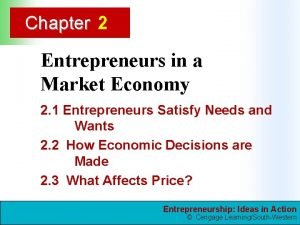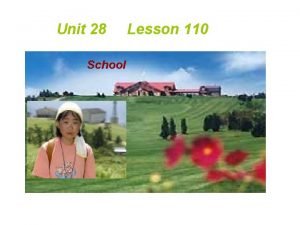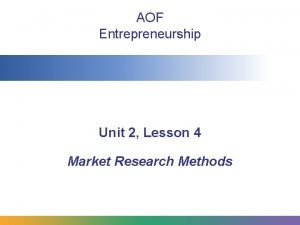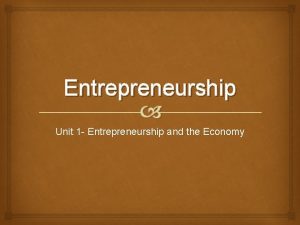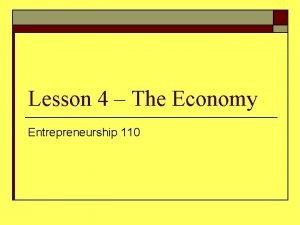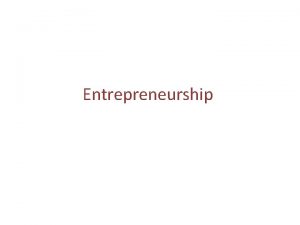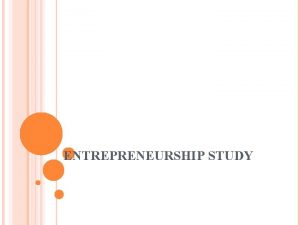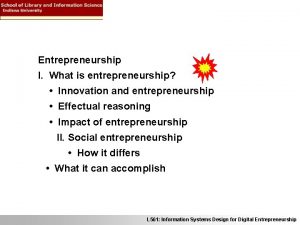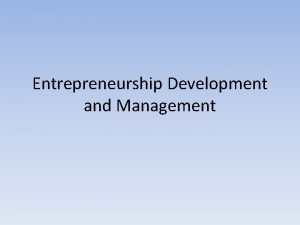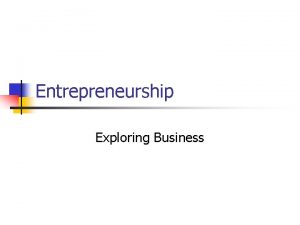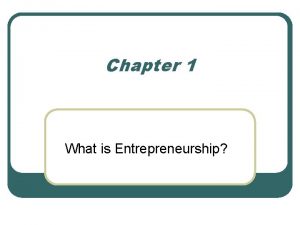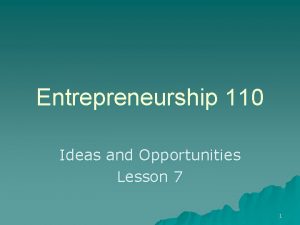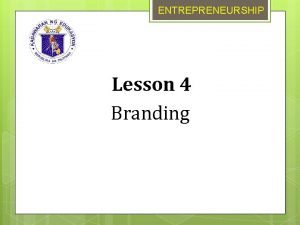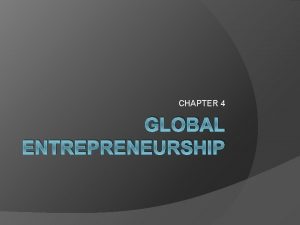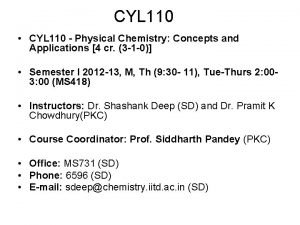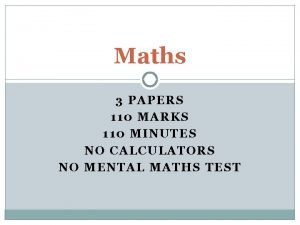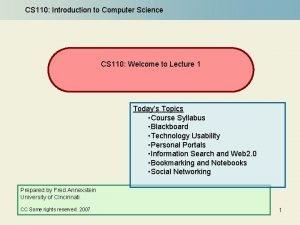Lesson 3 The Economy Entrepreneurship 110 1 Economy






















- Slides: 22

Lesson 3 – The Economy Entrepreneurship 110 1

Economy Defined o The “Economy” can be defined as: n The use of resources to produce and distribute goods and services. 2

The Three “Ages” o The three “Ages” of the Economy are: n The Agricultural Age (non-specific – 1750) n The Industrial Age (1750 – 1975) n The Information Age (1975 – present) 3

The Agricultural Age (non-specific – 1750) o The majority of people lived in rural areas and worked as farmers, blacksmiths, crafts people and merchants. o Customers knew who was producing the goods and services that they consumed. o Hard work and physical labour were valued. o Entrepreneurs first emerged during this age. 4

The Industrial Age (1750 – 1975) o People began to move from rural areas to urban areas (which became cities). o Equipment and machinery was invented to mass produce goods. 5

o o Majority of people are not self-employed, use of equipment, machinery, and assembly lines was the norm. The focus was on quantity, not quality. 6

o Entrepreneurship was discouraged during this age. o Employers wanted workers to follow routines, not have original ideas. o Working conditions were dangerous and wages were low. As a result, some of the first ever unions were formed. 7

Information Age (1975 – present) o We are in it! o For the first time, information and knowledge are valued more than anything else. Computers are so important during this age because they have changed how we share information of all kinds. People can work any where, because of computers, tech, and advances in communication o o 8

The Information Age Here are some startling facts: o o More information was produced in the last 20 years than the previous 5, 000 Information is doubling every 4 years A typical weekday edition of The New York Times contains more information than a person would encounter in a lifetime in the 17 th century 80% of new jobs require sophisticated information handling skills 9

More Facts o Jobs that involve the Internet pay about 50% more than jobs that do not o Artificial intelligence is expected to affect 60 -90% of all jobs in organizations--augmenting, displacing, or eliminating workers o In the next five years, 80% of workers will be doing jobs differently from the way they have done them over the past 50 years 10

o o o “Technology drives skills. It does so by creating new industries from semiconductors to software and reshaping long established industries from banking to retailing. In a very real sense, technology is the economy: the prevailing division and organization of labour. ” - ICTC’s Wireless Technology Roadmap: 2006 -2016 - Information and Communications Technology Council website 11

o Alvin Toffler, a Sociologist said the following about the Information Age: n “The illiterate of the 21 st Century will not be those who cannot read and write, but those who cannot learn, unlearn and relearn. ” What does this quote mean? 12

Quote Explained o What Alvin Toffler is saying in the previous quote is: n n n How we receive and transmit information is changing by the day. We must be able to learn how to transmit information (operating a Discman), unlearn (leave that information behind) and relearn (operating an MP 3 player, or an Ipod). If you are unable to do this, or refuse to, you will be considered “illiterate. ” 13

How can entrepreneurs have a positive impact on the local economy? o Job Creation – employees, producers, etc. o New Ideas – new ways of doing things (new & improved products & services) o Help contribute to local, regional and national economic growth. 14

o Compete with one another, which improves production, quality & keep prices down o Provide a spirit of energy, initiative & potential for progress to a community o Can increase and or bring tourism 15

What is Intrapreneurship? Intrapreneurship: o Entrepreneurship that occurs within a company o Encourages competitiveness, productivity, etc. o May take the form of: teams within a company; inviting customers to be part of the creative process; offering rewards for innovation. o How Google fosters intrapreneurship 16

The Changing Workplace o The new economy is forcing workplaces to change the way they operate if they want to be successful. Factors influencing these changes include n Globalization n Competition n Applications of new technology n E-commerce n The focus on quality n The needs of employers/employees n Changing customer demands (Green products, Organic, Healthier Lifestyles) n The current economic situation (Recession, Depression) n Concerns for human rights (Not using child labour) 17

Technology & Change Positive Affects of Technology: o o o The growth of e-commerce (online business) has made it possible for small businesses to compete with large ones; the playing field has been evened out. Entrepreneurs now have access to large data banks and search engines; small businesses can gather more kinds of information faster than they ever could before. Inexpensive software is on the market to help small businesses. Can work/shop at home. Easier to communicate Easier to advertise 18

Negative Affects of Technology o o o A negative effect of technological change is job loss due to downsizing. Much of the technology created has eliminated the need for human employees. Downsizing – to reduce operating costs in an organization by reducing the number of employees; often takes the form of layoffs. Lack of Privacy- people can reach you anytime and any where. Hard to escape work. More expectations to work longer hours. Cyber bullying. Less communication (face to face) 19

What was the oldest entrepreneurial venture in Canada? o The oldest company in Canada – The Hudson’s Bay Company, now referred to as simply HBC and owner of The Bay and Zellers. 20

Terms to know… Labour - is the economic that includes all forms of human effort that result in the production of a good or service in exchange for a wage or salary. Natural Resources – bestowed by nature and comes from the land, ex. fish, trees, etc. Capital Resources – man made, used in the production of goods. (saws, drills, pizza ovens) Wage – paid by the hour for labour Salary – paid a lump sum, usually a yearly salary 21

Globalization – the expansion of businesses and markets based on worldwide independence. Supply is the quantity of goods that a supplier has available to sell Demand is the amount of goods that consumers are willing/want to purchase 22
 Vignette mutuelle 110/110
Vignette mutuelle 110/110 110 000 110 & 111 000 111
110 000 110 & 111 000 111 Introduction to entrepreneurship module pdf
Introduction to entrepreneurship module pdf Chapter 2 assessment entrepreneurs in a market economy
Chapter 2 assessment entrepreneurs in a market economy Lesson 110
Lesson 110 Athenian economy vs sparta economy
Athenian economy vs sparta economy Unit 2 entrepreneurship
Unit 2 entrepreneurship Lesson plan in entrepreneurship grade 6
Lesson plan in entrepreneurship grade 6 Hát kết hợp bộ gõ cơ thể
Hát kết hợp bộ gõ cơ thể Bổ thể
Bổ thể Tỉ lệ cơ thể trẻ em
Tỉ lệ cơ thể trẻ em Chó sói
Chó sói Chụp phim tư thế worms-breton
Chụp phim tư thế worms-breton Hát lên người ơi
Hát lên người ơi Các môn thể thao bắt đầu bằng từ đua
Các môn thể thao bắt đầu bằng từ đua Thế nào là hệ số cao nhất
Thế nào là hệ số cao nhất Các châu lục và đại dương trên thế giới
Các châu lục và đại dương trên thế giới Cong thức tính động năng
Cong thức tính động năng Trời xanh đây là của chúng ta thể thơ
Trời xanh đây là của chúng ta thể thơ Mật thư anh em như thể tay chân
Mật thư anh em như thể tay chân Làm thế nào để 102-1=99
Làm thế nào để 102-1=99 độ dài liên kết
độ dài liên kết



